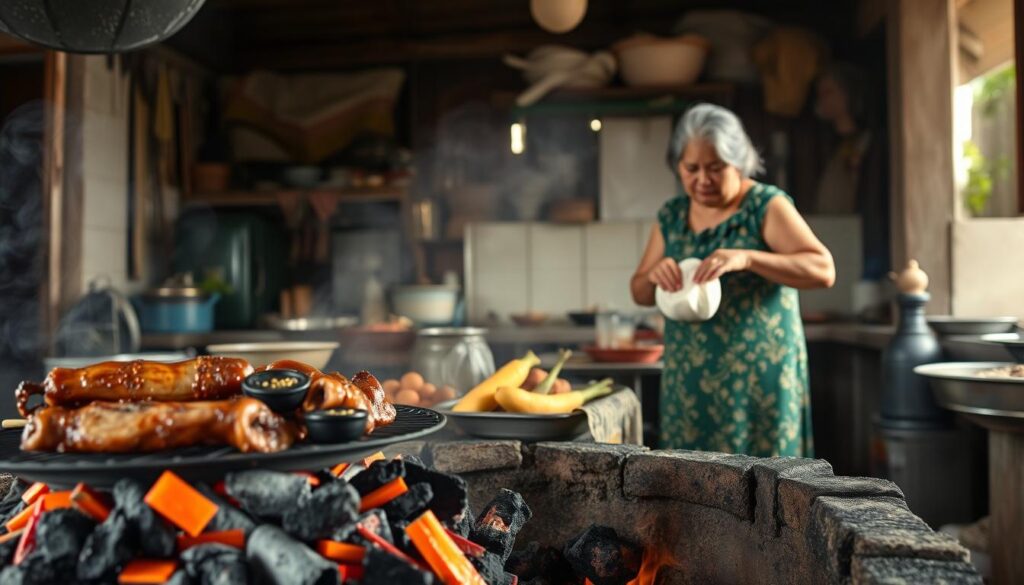Family Mealtime Traditions in Filipino Households

Julie Hopkins grew up surrounded by the clatter of pots and the warmth of a bustling kitchen. With eight siblings, her childhood revolved around shared responsibilities – peeling garlic, stirring simmering pots, and setting the table for gatherings that often included 15-20 relatives. “Our home wasn’t just a place to eat,” she recalls. “It was where we connected over steaming rice and stories.”
In many households, the dining table acts as a cultural anchor. Dishes like adobo and fried milkfish aren’t just recipes – they’re bridges between generations. Rice, served three times a day, anchors every meal, while practices like kamayan (eating with hands) deepen bonds through tactile connection.
These rituals reflect core values like Pakikisama (harmony) and respect for elders. Leftovers are rarely wasted; neighbors often receive portions wrapped in banana leaves. Even modern adaptations, like Julie’s Texas-inspired sinigang, preserve this spirit of creativity and community.
Key Takeaways
- Rice serves as the foundation of daily meals, paired with flavorful dishes like adobo or sinigang.
- Communal cooking fosters teamwork and preserves generational knowledge of traditional recipes.
- Cultural values like togetherness (Pakikisama) shape how food is prepared and shared.
- Leftovers are creatively repurposed, minimizing waste while strengthening neighborhood ties.
- Modern adaptations maintain cultural essence through flexible ingredient substitutions.
Cultural Roots and Family Bonds
Kitchens served as living classrooms where elders preserved heritage through daily rituals. For generations, homes buzzed with activity as grandparents taught traditional recipes to wide-eyed learners. “Measure rice by knuckle depth, not cups,” Julie’s Aunt Annie would say, demonstrating techniques older than the wooden kalan stove.

Historical Context and Traditional Practices
Multi-generational homes shaped culinary customs. Three households often shared one roof, creating spaces where food preparation became collaborative art. Mothers taught daughters to balance vinegar and soy sauce for adobo while fathers showed sons how to select ripe mangoes at market.
Intergenerational Cooking Lessons and Memories
Learning happened through doing. Children peeled garlic cloves as elders narrated stories of wartime resourcefulness. Julie recalls her mother’s hands guiding hers: “Fold the lumpia wrapper tight – loose rolls mean hungry ghosts might steal your fill.”
The Role of Rice and Staple Dishes
Grains formed more than meals – they symbolized unity. A pot of steaming rice always sat at the table’s center, surrounded by shared dishes like tinola chicken soup. “No one eats alone,” elders reminded, reinforcing that nourishment meant more than filled stomachs.
“Every grain you waste is a tear your ancestors shed planting rice paddies.”
Spices like turmeric and coconut milk carried history in their aromas. These flavors didn’t just feed bodies – they preserved identities across oceans and eras.
Family Mealtime Traditions in Filipino Households
Julie’s Texas kitchen hums with innovation. When traditional ingredients prove scarce, resourcefulness becomes the secret spice. Families blend old-world techniques with local produce, creating dishes that honor heritage while embracing new environments.
Modern Adaptations in the U.S. Setting
Spaghetti noodles replace rice sticks in pancit, while spinach substitutes for hard-to-find malunggay leaves. These swaps solve practical challenges but also spark creativity. Julie’s adobo now features carrots – a nod to her children’s preference for colorful plates.
Cookbooks sit beside handwritten recipe cards in many homes. Younger generations learn through written instructions rather than oral guidance. Yet the essence remains: “Measure soy sauce by taste, not tablespoons,” Julie reminds her daughter during weekend cooking sessions.
Blending Traditional Recipes with New Ingredients
Cross-cultural dishes like sushi bake – a mashup of Japanese technique and Filipino flavors – showcase culinary evolution. Even staple meals adapt: beef nilaga simmers with locally sourced potatoes instead of traditional taro.
| Traditional Dish | U.S. Adaptation | Cultural Influence |
|---|---|---|
| Pancit bihon | Spaghetti noodles | Italian-American |
| Chicken adobo | Added carrots | Health-conscious |
| Sinigang soup | Texas pinto beans | Southwestern |
| Bibingka | Oven-baked method | Modern appliances |
Parents consciously involve kids in these updated cooking processes. “Peeling garlic connects them to my childhood,” Julie notes. Through these adapted rituals, cultural roots grow deeper in foreign soil.
Building Community Over Food
The aroma of simmering sinigang soup often signaled more than just dinner in Julie’s neighborhood. Weekend potlucks became lifelines for transplanted families, blending lumpia rolls with Tex-Mex dips. These gatherings transformed strangers into kin through shared platters and laughter echoing across folding tables.
Shared Experiences and Celebratory Gatherings
Fiestas stretched dining tables into streets during Julie’s childhood. Relatives would arrive bearing lechon pork and bibingka rice cakes. “Our block parties fed 50 people minimum,” she recalls. “Cousins traded recipes while uncles debated basketball over sizzling sisig.”
Modern adaptations thrive through kamayan feasts where banana leaves replace plates. Nestlé’s BRAND TALK research confirms: families cooking together report stronger communication skills. During pandemic lockdowns, Julie’s Zoom cook-alongs preserved this spirit. Neighbors exchanged care packages containing adobo kits and handwritten notes.
Creating a Sense of Home Through Food
Newcomers find comfort in familiar flavors. Julie’s friend Maricel hosts “bring-your-own-rice” dinners for homesick nurses. “Steaming bowls of arroz caldo heal tough shifts,” she explains. Children learn cultural pride by wrapping turon spring rolls alongside grandparents.
Key community-building practices include:
- Prayer circles before meals, honoring harvests and loved ones
- Recipe swaps at church basements and community centers
- Birthday celebrations featuring 12 round fruits for prosperity
As Julie notes: “Our dishes carry stories. When we share them, we’re passing torches.” This edible heritage turns apartments into hearths and neighbors into chosen family.
Conclusion
Culinary traditions bridge oceans, linking past and present through flavor. These practices preserve cultural identity while adapting to new environments. Shared meals around the table remain powerful acts of unity, turning simple dishes into vessels for heritage.
From ancestral villages to American suburbs, recipes evolve without losing their soul. Substituting spinach for malunggay or adding carrots to adobo shows creativity rooted in respect. This flexibility lets traditions thrive, whether through pandemic Zoom cook-alongs or blended sushi-bake feasts.
Parents and grandparents play vital roles in this continuity. Teaching children to peel garlic or fold lumpia wrappers becomes more than cooking lessons – it’s how generations exchange stories and values. Community potlucks extend this learning, transforming neighbors into extended family.
These customs offer more than nourishment. They create a sense of belonging that transcends geography. As you gather around your own table tonight, consider the legacy in your food. What stories will your meals tell future generations?






